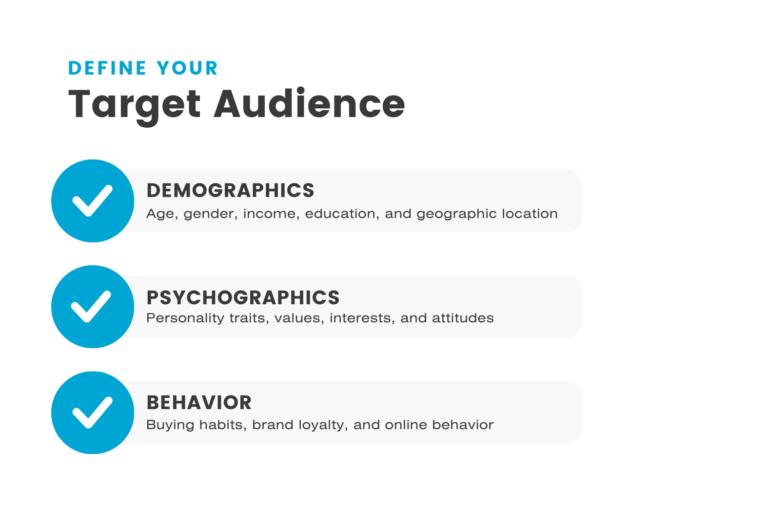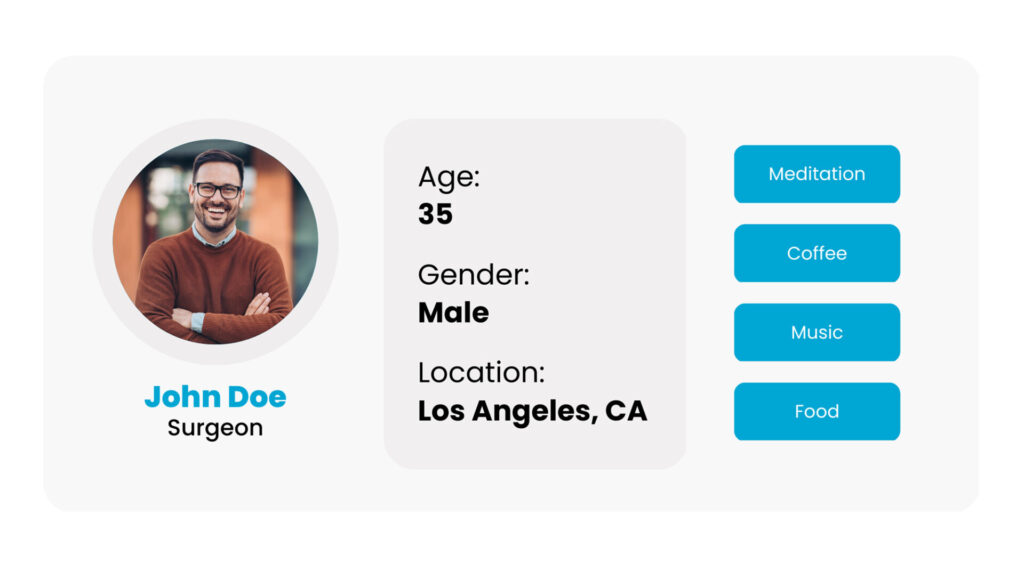Define Your Ideal Customer

Demographics include things like age, gender, income, education, and geographic location. Psychographics include personality traits, values, interests, and attitudes. Behavior includes things like buying habits, brand loyalty, and online behavior.
To define your ideal customer, start by creating a persona or profile that represents the person you want to reach. Give your persona a name, age, job title, and other demographic information. Then, think about their psychographics and behavior. What are their values, interests, and attitudes? What are their buying habits? What are their pain points? Where do they spend their time online?

IMAGINE THIS:
John is a 35 year old white male who works as a surgeon in Los Angeles, CA. He wakes up every morning to the obnoxious standard iPhone alarm, rolls out of bed, makes a pot of coffee, then does a calming meditation. As he drives to work in his Lexus GS350, he listens to Taylor Swift’s new album on Apple Music as he drinks his hot coffee out of his Stanley cup he bought off of Amazon because he saw it was trending on TikTok. He was skeptical of buying it at first because he’s found himself easily influenced by advertisements on TikTok in the past. Oftentimes, these products he’s purchased have left him feeling as though he was scammed out of his money. He believes that most products promoted on TikTok tend to not function the way the influencers claim they do. But, he is happy with his Stanley cup because he likes brands that are environmentally conscious, and that’s exactly what Stanley represents.
Once you play around with personas a bit, you’ll find that they are quite helpful in identifying who your ideal customer is. You can use this persona as a guide when creating your marketing campaigns. Everything from your messaging to your imagery should be designed to appeal to this persona.
Conduct Market Research
The next step in identifying your target audience is to conduct market research. This involves gathering data about your industry, competitors, and customers. The goal of market research is to better understand the needs and preferences of your target audience and identify opportunities for growth.
There are several different methods of market research, including surveys, focus groups, and social media listening. Surveys are a great way to gather quantitative data about your audience. You can use tools like SurveyMonkey to create surveys that ask questions about demographics, preferences, and behavior.
Focus groups are a more qualitative approach to market research. You can gather a group of people together and ask them questions about your product or service. This can help you understand their attitudes and perceptions.
PRO TIP:
To ensure your focus group data is useful, it is important to gather a group of unbiased individuals. You’d be surprised by the number of people who’d be happy to get together by offering small incentives, such as a $5 gift card to a coffee shop.
Social media listening involves monitoring social media channels for mentions of your brand or industry. You can use tools like Hootsuite or Sprout Social to monitor social media conversations and identify trends and opportunities.
Analyze Your Data
Once you’ve gathered data through market research, it’s time to analyze it. Look for patterns and trends in the data that can help you better understand your target audience. For example, you might find that your ideal customer is just like John, a male between the ages of 30 and 35, living in Los Angeles or the surrounding areas, and interested in sustainable living.
Analyzing your data can also help you identify gaps in the market. For example, you might find that there is a lack of products or services that cater to a specific demographic or interest group. This can present an opportunity for your business to fill that gap.
Use Analytics Tools
Another way to identify your target audience is to use analytics tools. These tools can help you track website traffic, social media engagement, and other metrics that can provide insights into your audience.
Google Analytics is a popular analytics tool that can help you track website traffic and user behavior. You can use this tool to see how many people are visiting your site, how long they are staying, and what pages they are viewing. For example, John is the kind of person who is always looking to learn new information on things. As you run analytics on John, you’ll find that he spends the most time on the blog section of your website. Thus, you may want to consider including a call to action in your blogs or introduce product placement throughout them. Since your audience spends a lot of time here, they’ll be enticed to buy your product based on the information they are receiving relating to it and how convenient it is to purchase it.
Social media analytics tools like Facebook Insights and Twitter Analytics can help you track engagement with your social media posts. You can see how many people are liking, commenting, and sharing your content, as well as demographic information about your followers.
Test and Refine Your Strategy
Identifying your target audience is an ongoing process. As you launch new marketing campaigns and gather more data, you may need to adjust your strategy to better reach your target audience. Testing and refining your strategy based on real-world data is key to developing a marketing approach that resonates with your customers.
Monitor and Adapt to Changes In the Market
Finally, it’s important to stay attuned to changes in the market that may impact your target audience. For example, if there is a new trend or technology that is disrupting your industry, it’s important to understand how this may impact your target audience and adjust your marketing strategy accordingly. Keeping a close eye on industry trends and developments can help you stay ahead of the curve and continue to effectively reach your target audience.

Final Thoughts
Identifying your target audience is a critical component of any successful marketing strategy. By defining your product or service, conducting market research, creating buyer personas, analyzing your existing customers, and testing and refining your strategy, you can create a tailored marketing approach that resonates with your ideal customers and drives conversions.
Obviously, these things take a nice chunk of time. Lucky for you, you’re one call away from having one of the best full-service digital marketing teams take care of it all. Reach out to us today to see how we can help you.
